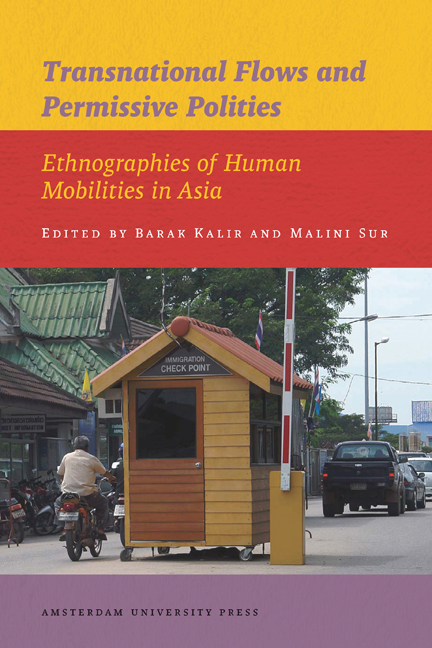Book contents
- Frontmatter
- Contents
- List of Tables, Maps, Figures and Photographs
- Acknowledgements
- Introduction: Mobile Practices and Regimes of Permissiveness
- 1 Illegality Rules: Chinese Migrant Workers Caught up in the Illegal but Licit Operations of Labour Migration Regimes
- 2 Contesting the State of Exception in the Afghan-Pakistani Marchlands
- 3 ‘Looking for a Life’: Rohingya Refugee Migration in the Post-Imperial Age
- 4 Smuggling Cultures in the Indonesia-Singapore Borderlands
- 5 Trade, Transnationalism and Ethnic Infighting: Borders of Authority in Northeast Borneo
- 6 Bamboo Baskets and Barricades: Gendered Landscapes at the India-Bangladesh Border
- 7 Moving between Kerala and Dubai: Women Domestic Workers, State Actors and the Misrecognition of Problems
- 8 Emigration of Female Domestic Workers from Kerala: Gender, State Policy and the Politics of Movement
- 9 Mainland Chinese Migrants in Taiwan, 1895-1945: The Drawbacks of Being Legal
- 10 ‘Playing Edge Ball’: Transnational Migration Brokerage in China
- Epilogue: Irregular Mobilities and Disjunctive Moralities
- About the Editors and Contributors
- Bibliography
- Index
- Publications Series
5 - Trade, Transnationalism and Ethnic Infighting: Borders of Authority in Northeast Borneo
Published online by Cambridge University Press: 15 January 2021
- Frontmatter
- Contents
- List of Tables, Maps, Figures and Photographs
- Acknowledgements
- Introduction: Mobile Practices and Regimes of Permissiveness
- 1 Illegality Rules: Chinese Migrant Workers Caught up in the Illegal but Licit Operations of Labour Migration Regimes
- 2 Contesting the State of Exception in the Afghan-Pakistani Marchlands
- 3 ‘Looking for a Life’: Rohingya Refugee Migration in the Post-Imperial Age
- 4 Smuggling Cultures in the Indonesia-Singapore Borderlands
- 5 Trade, Transnationalism and Ethnic Infighting: Borders of Authority in Northeast Borneo
- 6 Bamboo Baskets and Barricades: Gendered Landscapes at the India-Bangladesh Border
- 7 Moving between Kerala and Dubai: Women Domestic Workers, State Actors and the Misrecognition of Problems
- 8 Emigration of Female Domestic Workers from Kerala: Gender, State Policy and the Politics of Movement
- 9 Mainland Chinese Migrants in Taiwan, 1895-1945: The Drawbacks of Being Legal
- 10 ‘Playing Edge Ball’: Transnational Migration Brokerage in China
- Epilogue: Irregular Mobilities and Disjunctive Moralities
- About the Editors and Contributors
- Bibliography
- Index
- Publications Series
Summary
Nunukan, the northernmost district of the Indonesian province of Kalimantan, is literally on the outskirts of the Indonesian state. Its long and narrow territory stretches from the Sulawesi Strait in the east to the rugged mountainous interior of the highland plateaus of northern Borneo's interior in the west. The district shares a very long international border with the Malaysian states of Sabah (to the north) and Sarawak (to the west). Nunukan has a long history of trading with close and more remote partners, a market that was rather hampered by the incorporation of the area first into the Dutch East Indies and then into the Republic of Indonesia, and Nunukan's subjection to the laws of both regimes. For most of the twentieth century, Nunukan's official status was hence no more than that of a remote, sparsely populated and underdeveloped territory incorporated into the far larger district of Bulungan. All this changed after the fall of Suharto as president of Indonesia and the ensuing reform of the nation's administrative organisation.
Our approach to realms of authority in Nunukan is concerned with three essential points of departure. Our first issue is the source of authority. Official law, as a major and obvious source, gains meaning from what it authorises as much as from what it forbids. As such, the law and its negation are opposites that define and construct one another. The existence of the one gives shape to the other, making the possibility of transgression a property inherent to all law (Anders & Nuijten 2007: 12). The existence of state law thus gives rise to an interest in its counterparts (Heyman & Smart 1999: 1), which may be seen as more just, reasonable or simply more profitable. Second, authority is therefore not limited to official law. As Moore (1973) argued in introducing the concept of the ‘semi-autonomous social field’, multiple sources of authority may exist and co-exist in various spheres of influence. Official law is among those, but its authority may well be challenged by – or even overlap with – other sources of authority. Moore thus refers to social space as a metaphor for the realm in which an authority has validity, but he does not equate that realm to actual, physical territory. Our third premise is therefore that, as a field of authority need not be limited to physical territory, neither do its borders.
- Type
- Chapter
- Information
- Transnational Flows and Permissive PolitiesEthnographies of Human Mobilities in Asia, pp. 109 - 126Publisher: Amsterdam University PressPrint publication year: 2012

